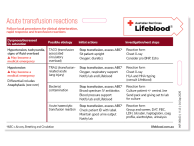Don’t have an account?
Select the donation type you’d like to make
When to suspect this adverse reaction
Characteristically begin with an increase in temperature and pulse rate.
Symptoms may include chills, rigors, dyspnoea, chest pain, flank pain, discomfort at infusion site, sense of dread, or abnormal bleeding, and may progress rapidly to shock.
Patients may develop oliguria, haemoglobinuria and haemoglobinaemia.
In anaesthetised patients, hypotension and evidence of disseminated intravascular coagulation (DIC) may be the first sign of a reaction.
Usual causes
Acute haemolytic reactions can be both immune-mediated or non-immune-mediated.
Immune-mediated reactions may be associated with:
- ABO/RhD mismatch
- red cell alloantibodies (non-ABO) as a result of immunisation from a previous pregnancy or transfusion, and
- rare cases when Group O donor platelets with high titres of anti-A or anti-B are transfused to a non-Group O recipient.
Transfused red cells are destroyed as a result of incompatibility between antigens on transfused donor red cells and an antibody in the recipient’s circulation.
The most severe reactions are associated with transfusion of ABO-incompatible red cells. This is typically the result of clerical errors or patient identification errors such as improper labelling of samples, administering the wrong blood to the patient or testing errors.
ABO-incompatibility occurs in about 1:40,000 transfusions.
As little as 10 mL of incompatible blood can rapidly produce symptoms of an acute haemolytic reaction. Haemolysis may also occur in the presence of non-ABO red cell alloantibodies in the patient’s plasma which have not been previously identified.
Occasionally a patient may have an antibody at levels below the detection capabilities of the antibody screening method. Rarely reactions are caused by uncrossmatched blood being given to an alloimmunised patient during an emergency transfusion.
Non-immune-mediated causes of haemolysis include physical or chemical destruction of transfused red cells such incorrect storage of red cells, transfusion through the wrong gauge of needle, incorrect use of a blood warmer, interaction with fluids transfused at the same time and bacterially contaminated red cell units.
Investigation
Clinically assess the patient for features of haemolysis.
Check clerical records, such as ABO group of the patient and transfused unit.
Blood group, antibody screen and direct antiglobulin test (DAT) on both pre- and post-transfusion samples.
Perform renal function, and tests for haemolysis (e.g. LDH, bilirubin, serum haptoglobin, electrolytes, creatinine, urinalysis).
What to do
- Stop transfusion immediately and follow other steps for managing suspected transfusion reactions.
- Seek urgent medical assistance.
- Maintain renal output.
- Induce diuresis with intravenous fluids and diuretics.
- Support blood pressure and maintain an open airway as this may become a medical emergency.
Do not restart the transfusion or administer additional blood components until cleared by a haematologist or Transfusion Service Provider.



